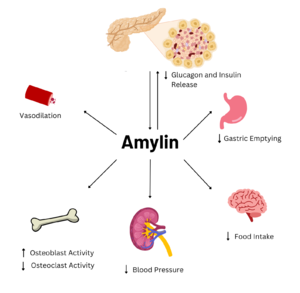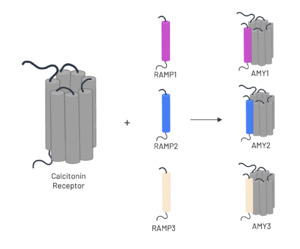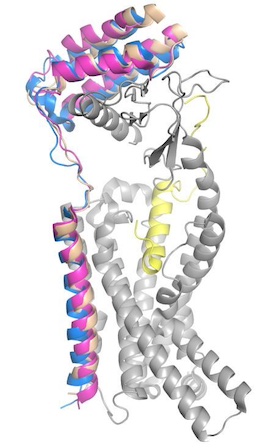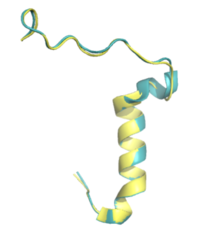User:Brynn Baker/Sandbox1
From Proteopedia
< User:Brynn Baker(Difference between revisions)
| (4 intermediate revisions not shown.) | |||
| Line 6: | Line 6: | ||
== Amylin == | == Amylin == | ||
| - | [[Image:AmylinFlowchart.png|300 px|right|thumb|Figure 1. Effects of Amylin in Humans]] | + | [[Image:AmylinFlowchart.png|300 px|right|thumb|Figure 1. Effects of Amylin in Humans. Image generated using ''Biorender''.]] |
Amylin is a neuroendocrine hormone that is synthesized with insulin in the [https://en.wikipedia.org/wiki/Beta_cell beta cells] of pancreatic islets. It can cross the [https://en.wikipedia.org/wiki/Blood%E2%80%93brain_barrier blood-brain barrier] and regulates glucose homeostasis via inhibiting gastric emptying, inhibiting the release of glucagon, and inducing meal-ending satiety<ref name="Hay">PMID:26071095</ref>. In doing so, it prevents spikes in blood glucose and overeating, making it a suitable target for [https://en.wikipedia.org/wiki/Type_2_diabetes Type 2 Diabetes] treatments and therapies. Since Type 2 Diabetes is a major risk factor for [https://en.wikipedia.org/wiki/Alzheimer%27s_disease Alzheimer's Disease], as Type 2 Diabetes cases continue to increase, there will likely be a spike in Alzheimer’s Disease as well<ref name="Grizzanti">PMID:30282360</ref>. Therefore, it is vital that amylin, its receptor, and analogs, such as pramlintide, are understood to aid in rational drug design. | Amylin is a neuroendocrine hormone that is synthesized with insulin in the [https://en.wikipedia.org/wiki/Beta_cell beta cells] of pancreatic islets. It can cross the [https://en.wikipedia.org/wiki/Blood%E2%80%93brain_barrier blood-brain barrier] and regulates glucose homeostasis via inhibiting gastric emptying, inhibiting the release of glucagon, and inducing meal-ending satiety<ref name="Hay">PMID:26071095</ref>. In doing so, it prevents spikes in blood glucose and overeating, making it a suitable target for [https://en.wikipedia.org/wiki/Type_2_diabetes Type 2 Diabetes] treatments and therapies. Since Type 2 Diabetes is a major risk factor for [https://en.wikipedia.org/wiki/Alzheimer%27s_disease Alzheimer's Disease], as Type 2 Diabetes cases continue to increase, there will likely be a spike in Alzheimer’s Disease as well<ref name="Grizzanti">PMID:30282360</ref>. Therefore, it is vital that amylin, its receptor, and analogs, such as pramlintide, are understood to aid in rational drug design. | ||
| Line 27: | Line 27: | ||
== Amylin Receptor == | == Amylin Receptor == | ||
The amylin receptor (AMYR) is the result of the heterodimerization of the <scene name='10/1037516/Ct/2'>calcitonin receptor</scene> and a RAMP, such as <scene name='10/1037520/Ramp3/5'>RAMP3</scene>. The patterns of peptide interaction between CT and AMYR are very similar overall, but amylin has a higher affinity for AMYR1 and AMYR3 than AMYR2<ref name="Cao">PMID:35324283</ref>. | The amylin receptor (AMYR) is the result of the heterodimerization of the <scene name='10/1037516/Ct/2'>calcitonin receptor</scene> and a RAMP, such as <scene name='10/1037520/Ramp3/5'>RAMP3</scene>. The patterns of peptide interaction between CT and AMYR are very similar overall, but amylin has a higher affinity for AMYR1 and AMYR3 than AMYR2<ref name="Cao">PMID:35324283</ref>. | ||
| - | [[Image:AMYR.png|300 px|left|thumb|Figure 3. Heterodimerization of CT and RAMPs]] | + | [[Image:AMYR.png|300 px|left|thumb|Figure 3. Heterodimerization of CT and RAMPs. Image generated using ''Biorender''.]] |
== Calcitonin Receptor and G-alpha Interactions == | == Calcitonin Receptor and G-alpha Interactions == | ||
| Line 43: | Line 43: | ||
<scene name='10/1037520/Hydrophobic_pocket/6'>Y37</scene> on the C-terminus of the amylin peptide has extensive van der Waals interactions with the CT and RAMP3. The pi stacking and hydrophobic interactions increase the affinity and interactions between the amylin peptide, CT, and RAMP3, aiding in their association. | <scene name='10/1037520/Hydrophobic_pocket/6'>Y37</scene> on the C-terminus of the amylin peptide has extensive van der Waals interactions with the CT and RAMP3. The pi stacking and hydrophobic interactions increase the affinity and interactions between the amylin peptide, CT, and RAMP3, aiding in their association. | ||
=== Amidated C-Terminus === | === Amidated C-Terminus === | ||
| - | Y37 of amylin is amidated. The <scene name='10/1037520/Amidated_cterm/2'>amide group</scene> forms a hydrogen bond with the backbone of S129 | + | Y37 of amylin is amidated. The <scene name='10/1037520/Amidated_cterm/2'>amide group</scene> forms a hydrogen bond with the backbone of S129 on the calcitonin receptor. All biological activity was lost when this amide group was experimentally removed<ref name="Cao">PMID:35324283</ref>. |
=== T6 === | === T6 === | ||
| Line 59: | Line 59: | ||
The first human amylin analogue, <scene name='10/1037520/Pramlintide_overall/2'>pramlintide</scene>, was developed in 1995, and marked a significant advancement in the treatment of Type 2 Diabetes<ref name="Bower">PMID:27061187</ref>. As of 2024, it is the only FDA-approved drug for the treatment of Type 2 Diabetes using the AMYR as a target. Recent studies in rodent Alzheimer’s Disease models suggest that pramlintide reduces amyloid-beta plaques, making it a potential therapeutic target for Alzheimer’s Disease<ref name="Grizzanti">PMID:30282360</ref>. | The first human amylin analogue, <scene name='10/1037520/Pramlintide_overall/2'>pramlintide</scene>, was developed in 1995, and marked a significant advancement in the treatment of Type 2 Diabetes<ref name="Bower">PMID:27061187</ref>. As of 2024, it is the only FDA-approved drug for the treatment of Type 2 Diabetes using the AMYR as a target. Recent studies in rodent Alzheimer’s Disease models suggest that pramlintide reduces amyloid-beta plaques, making it a potential therapeutic target for Alzheimer’s Disease<ref name="Grizzanti">PMID:30282360</ref>. | ||
| - | There is limited knowledge about how human amylin binds to the human AMYR, so many studies utilize rat amylin as the peptide for the human AMYR. Rat amylin and pramlintide showcase very similar structures and maintain a high sequence similarity. For instance, the N-term lysine residue is conserved between <scene name='10/1037520/K1/ | + | There is limited knowledge about how human amylin binds to the human AMYR, so many studies utilize rat amylin as the peptide for the human AMYR. Rat amylin and pramlintide showcase very similar structures and maintain a high sequence similarity. For instance, the N-term lysine residue is conserved between <scene name='10/1037520/K1/2'>rat amylin</scene> and <scene name='10/1037516/Pramlintide_k1/1'>pramlintide</scene>, as well as human amylin<ref name="Cao">PMID:35324283</ref>, suggesting that the lysine is integral for binding to AMYR. One of these residue changes is <scene name='10/1038871/Rat_pram_18/1'>R18 in rat amylin to H18 in pramlintide</scene>. Another mutation is <scene name='10/1037520/Rat_pram_19/3'>S19 in rat amylin to K19 in pramlintide</scene>. S19 is highly conserved in most observed variants of amylin, as the <scene name='10/1037520/S19/1'>sidechain of S19 hydrogen bonds to the backbone of P100 of CT</scene><ref name="Cao">PMID:35324283</ref> <ref name="Bower">PMID:27061187</ref>. Other mutations include <scene name='10/1038871/Rat_l23/1'>L23</scene> in rat amylin to <scene name='10/1038871/Pramlintide_f23/1'>F23</scene> in pramlintide and <scene name='10/1038871/Rat_v26/1'>V26</scene> in rat amylin to <scene name='10/1037516/Pramlintide_i26/1'>I26</scene> in pramlintide. While these residues differ, the overall properties of the various residues remain consistent, so many of the same interactions with AMYR are likely still able to form. |
| - | Rat amylin and pramlintide have 3 proline residues, which are absent in human amylin. Human amylin and pramlintide only differ at these 3 residues, with all three being changed to proline in pramlintide. The <scene name='10/1037520/Pramlintide_mutations_labeled/ | + | Rat amylin and pramlintide have 3 proline residues, which are absent in human amylin. Human amylin and pramlintide only differ at these 3 residues, with all three being changed to proline in pramlintide. The <scene name='10/1037520/Pramlintide_mutations_labeled/3'>Ala25Pro, Ser28Pro, and Ser29Pro</scene> mutations break the helical nature present in human amylin, which likely prevents the aggregation of amyloid beta plaques in Alzheimer’s Disease. |
</StructureSection> | </StructureSection> | ||
Current revision
Homo sapiens Amylin3 Receptor, AMYR3
| |||||||||||
References
- ↑ Hay DL, Chen S, Lutz TA, Parkes DG, Roth JD. Amylin: Pharmacology, Physiology, and Clinical Potential. Pharmacol Rev. 2015 Jul;67(3):564-600. PMID:26071095 doi:10.1124/pr.115.010629
- ↑ 2.0 2.1 Grizzanti J, Corrigan R, Casadesus G. Neuroprotective Effects of Amylin Analogues on Alzheimer's Disease Pathogenesis and Cognition. J Alzheimers Dis. 2018;66(1):11-23. PMID:30282360 doi:10.3233/JAD-180433
- ↑ 3.0 3.1 3.2 3.3 3.4 3.5 3.6 3.7 3.8 3.9 Cao J, Belousoff MJ, Liang YL, Johnson RM, Josephs TM, Fletcher MM, Christopoulos A, Hay DL, Danev R, Wootten D, Sexton PM. A structural basis for amylin receptor phenotype. Science. 2022 Mar 25;375(6587):eabm9609. PMID:35324283 doi:10.1126/science.abm9609
- ↑ 4.0 4.1 Bower RL, Hay DL. Amylin structure-function relationships and receptor pharmacology: implications for amylin mimetic drug development. Br J Pharmacol. 2016 Jun;173(12):1883-98. PMID:27061187 doi:10.1111/bph.13496
Student Contributors
- Brynn Baker
- Emily Berkman
- Sepp Hall





